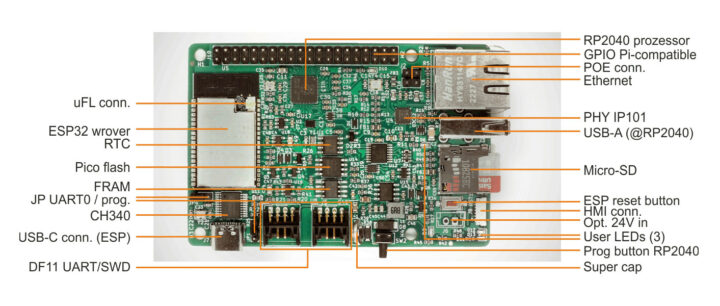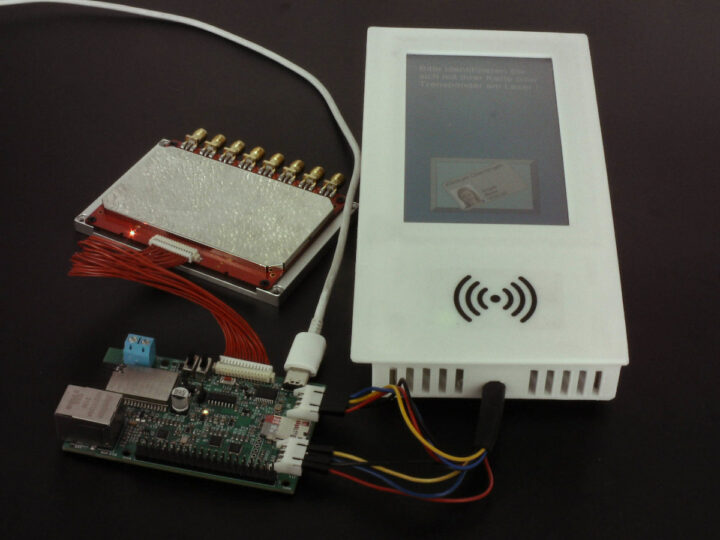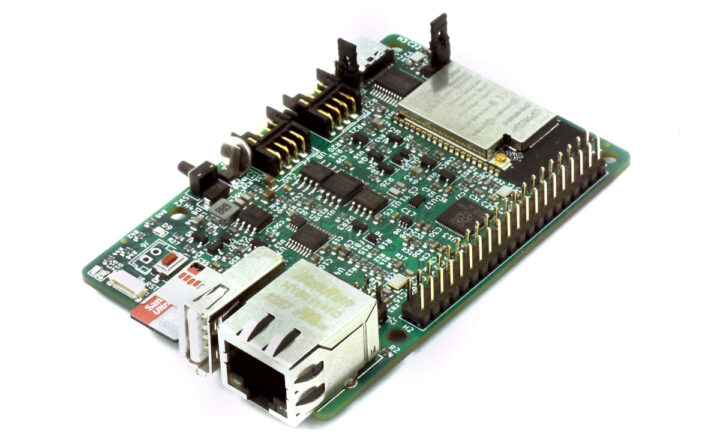The EsPiFF board may look like a Raspberry Pi 4 Linux SBC but it is equipped with an ESP32-WROVER WiFi and Bluetooth module together with a Raspberry Pi RP2040 microcontroller that acts as a co-processor.
The goal here is to provide a Raspberry Pi 4 replacement for applications that require higher reliability and even 24/7 operation without necessarily needing the processing power and multimedia capabilities of the Broadcom BCM2711 Arm processor found in the Pi or the versatility of a Linux operating system.
EsPiFF board specifications:
- Wireless module – ESP32-WROVER module with dual-core ESP32-D0WDQ6 microcontroller with 2.4 GHz WiFi 4 and Bluetooth, 8 MB PSRAM and 16 MB flash
- Co-processor – Raspberry Pi RP2040 dual-core Cortex-M0+ microcontroller @ up to 133 MHz with 16MB flash used to emulate the Raspberry Pi’s GPIOs on the 40-pin header
- Additional storage
- 2 KB of fast FRAM for permanent storage of process data. (faster alternative to EEPROM)
- 8 Mbit ISSI flash
- Unpopulated footprint for up to 512 Mbit ISSI flash
- MicroSD card socket
- Display – HMI connector for TFT displays such as Nextion serial displays.
- Connectivity
- 10/100M Ethernet via IP101 PHY that is said to have better stability than the widely used LAN8720, at least when connected to ESP32.
- 2.4 GHz Wi-Fi connectivity (ESP32) with external U.FL antenna
- USB
- 1x USB Type-A host port
- 1x USB Type-C port for power and programming (via CH340 USB-UART chip)
- Expansion
- 40-pin Raspberry Pi-compatible header for HATs with up to 100 MHz I/Os
- Up to 3x UART via header and DF11 connectors
- Debugging – Unpopulated JTAG header for developers
- Misc
- RTC chip with onboard supercap
- Watchdog
- BOOT button for RP2040 MCU to switch between USB programming and USB Host/device
- Reset button and 3x user LEDs for the ESP32
- Power Supply –
- 5V up to 3A via USB Type-C port
- PoE header to use the Raspberry Pi PoE HAT
- Dimensions – About the same as Raspberry Pi Model B boards
 I can already see some readers raising their hands up in the air or doing a facepalm before starting to write a comment complaining about the placement of the ESP32-WROVER module on the board since it would interfere with the PCB antenna operation, but we were told it was to keep the Raspberry Pi form factor to be able to reuse existing Pi enclosures and an external u.FL antenna is included in the kit.
I can already see some readers raising their hands up in the air or doing a facepalm before starting to write a comment complaining about the placement of the ESP32-WROVER module on the board since it would interfere with the PCB antenna operation, but we were told it was to keep the Raspberry Pi form factor to be able to reuse existing Pi enclosures and an external u.FL antenna is included in the kit.
The ESP32 and RP2040 microcontrollers communicate over SPI or UART, and by default, the board comes with NuttX RTOS, which has recently graduated as a top-level Apache project, but you can program it with the ESP-IDF, Arduino, and other ESP32 development tools. The Raspberry Pi RP2040 runs the Firmata firmware that currently only supports UART communication, and SPI is being worked on. You’ll find more technical details on the Github repository for the board including the KiCad schematics and PCB layout, as well as the firmware source code.

Some use cases where the EsPiFF board may be better suited than the more powerful Raspberry Pi include human-machine interfaces, outdoor applications where the board can be housed in a water- or air-tight enclosure without worrying about overheating, home and industrial automation installations, and more.
MDC-Service Wittenburg GmbH has launched the EsPIFF board on Crowd Supply with a $2,250 goal. The only reward is the $55 EsPiFF with all required cables. Shipping adds $8 to the US, and $18 to the rest of the world, and backers should expect their perks to ship in April 2023.

Jean-Luc started CNX Software in 2010 as a part-time endeavor, before quitting his job as a software engineering manager, and starting to write daily news, and reviews full time later in 2011.
Support CNX Software! Donate via cryptocurrencies, become a Patron on Patreon, or purchase goods on Amazon or Aliexpress





